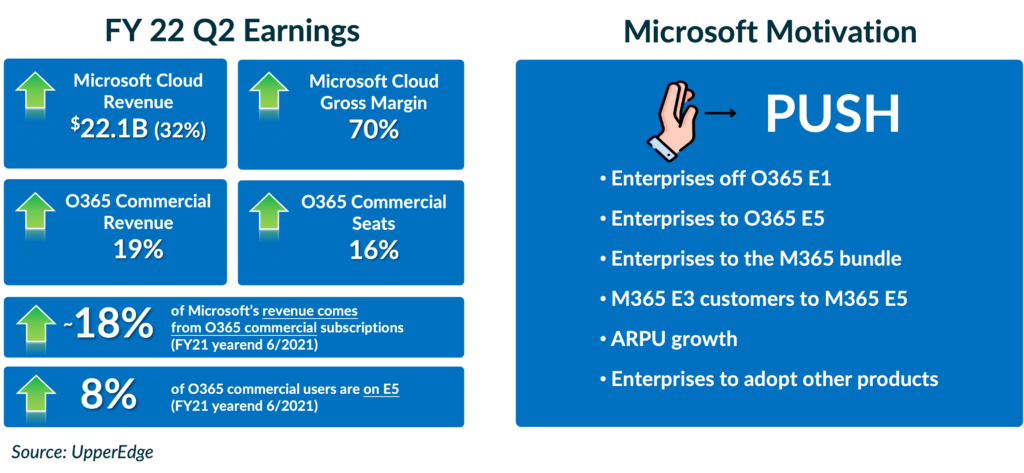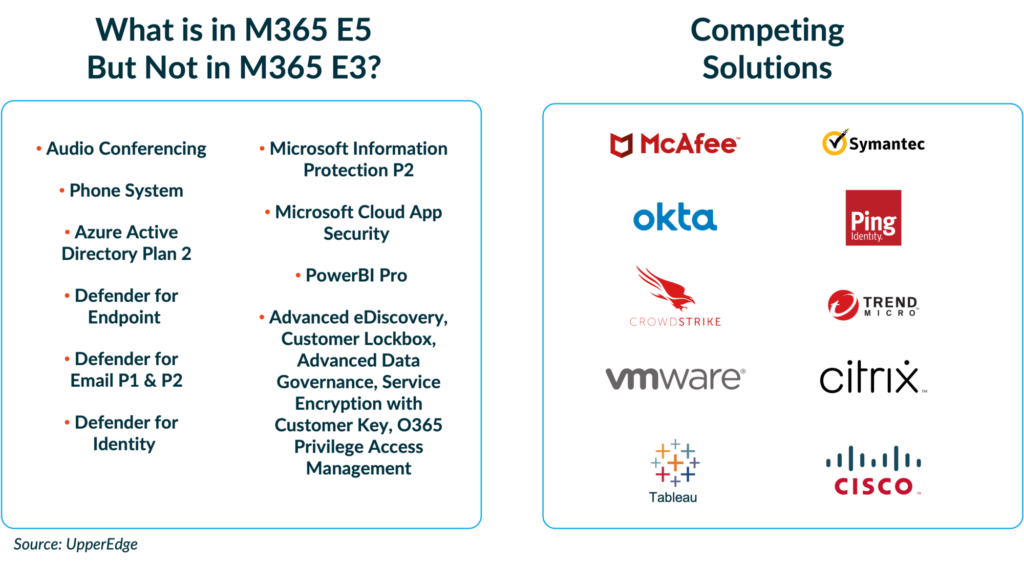- March 15, 2022
- Adam Mansfield
- Reading Time: 6 minutes

Microsoft’s recently announced enterprise price increases to some Office 365 and Microsoft 365 product suites are here, so customers should take note on how the increases will impact them.
Microsoft justified these price increases for two reasons. First, there hasn’t been a price increase to these product suites in over a decade. Second, over that 10-year period, there has been considerable value added to the Office 365 and Microsoft 365 product suites.
Microsoft specifically pointed out that there were 24 new apps and 1,400 new features added since Microsoft 365 was rolled out, including Microsoft Teams, OneDrive and the Power Platform apps. Further, Microsoft touted their ability to innovate in the ‘community and collaboration’, ‘security and compliance’, and ‘AI and automation’ spaces since the introduction of Office 365 to further illustrate the value that has been added to their product suites over time.
Understanding these price increases and why Microsoft added them will be critical to your negotiation strategy moving forward.
Why Microsoft Increased Their Pricing
Microsoft is really drawing attention to the value added to their product suites over the past 10 years to justify this price increase. But if you take the Power Platform as an example, which Microsoft cites as a key value-add, the version of these products included in the Microsoft 365 product suites is water-downed. Customers need to pay more for premium versions to get the increased value they are often looking for.
While many customers have already moved to the Microsoft 365 bundle, they will need to move up to E5 for advanced security, compliance and voice offerings, which all continue to drive momentum in E5 revenues. Movement to E5 will drive average revenue per user and overall cloud revenue for Microsoft.
Outside of value add, when you think about the fact that Commercial Office 365 and Microsoft 365 bundle subscriptions represent a meaningful portion of Microsoft’s Cloud revenue, it comes down to also finding ways to increase this revenue stream. One way to do that is to simply increase the often talked about average revenue per user (ARPU), something all cloud vendors are focused on. If the underlying list price goes up across key products like Office 365 and the all-in cloud bundle Microsoft 365, that’s a fast way to increase the ARPU tied to their entire base of customers using these products.

Microsoft is also ultimately trying to move their customers to the Microsoft 365 E5 or even E3 bundles. If you increase the Office 365 components of these all-in cloud bundles, which also have Windows Online and EMS, it certainly helps “motivate” (or perhaps force) customers to consider moving to the more robust bundle.
What is NOT Increasing
Microsoft 365 E5, the most robust bundle offering, is staying at its $57 list price without any increases. It is clear that Microsoft will remain focused on leveraging their premium security, compliance, voice, and analytics solutions to get enterprise customers to move to the more robust (and costly) M365 E5.
During the FY21 earnings call, CFO Amy Hood said that only 8% of their roughly 300 million Office 365 users are on Office 365 E5. Interestingly, Microsoft has not given an update on this percentage since June of last year and they had two earnings calls to do so. Perhaps, the percentage didn’t get big enough yet? Clearly, Microsoft needs to make this percentage a lot bigger, and they would love to put it out there for analysts, investors, customers and competitors to see.
By making these price increases, it is making Office 365 E5 more appealing and, as mentioned, it is also making Microsoft 365 E5 more appealing to enterprise customers because the gap between Office 365 E1 and E3 is much smaller when compared to Office 365 E5. The gap in cost between Microsoft 365 E3 and Microsoft 365 E5 is also smaller now when you look at them comparatively because the Microsoft 365 E3 list price is going up, but the Microsoft 365 E5 list price is not.
You may have noticed that there are also key solutions that Microsoft didn’t increase. Firstline worker SKUs like Microsoft 365 F1, Microsoft 365 F3, and Office 365 F3 will not see an increase. Deskless workers are an area where Microsoft is most vulnerable right now. Organizations that are starting to consider giving digital capabilities to their deskless workers are often also considering Google Workspace. This is the primary area where Microsoft knows they need to keep Google out, so it makes sense that they will not increase these prices. This is attractive to the companies who are expanding use for the larger connected corporation and firstline worker universe.
Microsoft 365 E5 vs. E3
Microsoft 365 E5 is Microsoft’s go-to solution for robust security, voice and analytics. The table below shows some of the solutions that are part of E5 but are not in E3. Not coincidentally, these are the areas where most enterprises are focused right now and are investing heavily. If you look to the right half of the chart, you will see who the strongest competitors are in those areas. Many companies may have longstanding relationships with some of these competitors and many have multiple sets of these products. If you value those solutions and don’t necessarily have plans to move off, that is a problem for Microsoft.

What Should Customers Do?
Considering these list price increases, there are a few things that your organization can do to prepare for your next negotiation or renewal with Microsoft. First, hopefully you have renewal term price protections in place that adequately address the level of increase Microsoft can apply at your upcoming renewal. If you do, and your renewal is after March 2022, you may be in a good position. Of course, that is assuming the pricing you negotiated last time is what it should be.
Protecting a price that is not worth protecting in the first place is certainly problematic and would need to be addressed. Unfortunately, many customers do not have renewal term price protections in place and having to deal with list price increases on top of the normal increases these customers are hit with is going to be painful and challenging to adequately address.
Customers also need to set aside the necessary amount of time to carefully assess their current utilization of products as well as the actual value received to date. As part of this, they need to look closely at the expected go-forward value as well. In other words, if something has not been used to date, are there plans to use it in the near future? What is your roadmap?
Microsoft wants to talk about all the added value and features as a means to justify the upcoming list price increases. The fact is if the added features are actually being used and will be used moving forward, then a case can certainly be made that there is value that wasn’t there before and perhaps an increase to the list price can be much easier to swallow.
Customers need to be armed with granular-level knowledge of their use, especially in these cases where value is not being realized, as it will help shape and drive the negotiation with Microsoft. Also, by showing Microsoft what has not been utilized, you can push for them to step up and provide investments to ensure your company does get the expected value through use moving forward. This would be in addition to appropriate and compelling pricing.
Of course, it is important to note that no Microsoft customer is using every feature in a given product suite. These customers don’t have to use every feature to be getting value from the product suite – they just need to use enough key aspects and features.
Critical Questions
Knowledge is truly power when you negotiate your Microsoft renewal and after all, they come to the negotiation with a lot of leverage. Ask these questions well before the renewal:
- How have you been treated from Microsoft so far from a commercial perspective compared to the market?
- Do you have transparency into your pricing?
- Do you have transparency into future product pricing? For example, if you’re a Microsoft 365 E3 customer, did you lock in and get transparency into what the E5 step up would look like?
- Do you have access to the list price? The volume list price?
- Do you know what the discounted price would be to make the step up to E5?
- Was your previous discounting a special one-time discount to jump to the Microsoft 365 E3 bundle? For example, will it go away after year one?
- Do you have future price protections in place?
- Do you have the proper level of investments?
- Did you get dollars that you can use on other service providers who can help unlock any lost value?
It’s good that Microsoft has put these price increases out there so customers can prepare – it’s better to know now than to find out upon your renewal. But programmatic price increases are not as important as assessing the value derived from current solutions and the needs of the future. Of course, you need to also assess whether or not the pricing you have been living with has been appropriate as well. And don’t forget to remind Microsoft of CFO Amy Hood’s statement on their last earnings call, “We are really focused on getting the right deal done that matches the customer’s goals.”
Related Blogs
Understanding Microsoft’s Removal of From SA SKUs: Customer Impacts and Recommendations
What Matters Most to Microsoft in 2024
4 Major Updates to Copilot for Microsoft 365: What Customers Need To Know
About the Author
